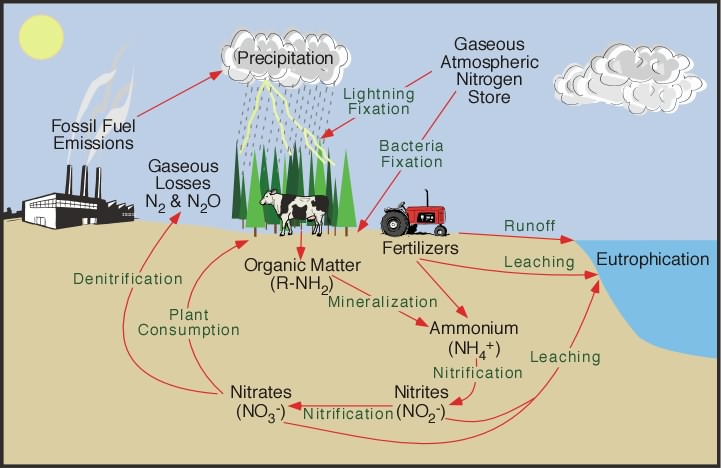Nitrogen is an important molecule that makes up nearly 78 percent of the atmosphere. Burning fossil fuels and using fertilizers for agriculture are two ways that this number can increase. But the atmosphere isn’t the only place that nitrogen is found – it is also found in bodies of water. Of the nitrogen that is spread in fertilizers, only 25-30 percent is absorbed by plants, so that leaves a lot of nitrogen left to either be absorbed by the atmosphere or into water. Figure 1 shows the intricacies of the nitrogen cycle, from Physical Geography.net’s Fundamentals E-book:
According to a recent article in Science, most of the studies of nitrogen in bodies of water have been done on a local or regional scale. These studies focus on how local agriculture and manufacturing effect pollution in water that is used for drinking water around highly agricultural or industrial areas. This new study takes a look at the nitrogen levels in lakes and ponds thousands of miles away from the nearest city, industrial area, or farm.
How did this nitrogen arrive so far away from cities, farms, or industry? The study suggests that it is transported through the atmosphere and then returns to the ground through one of the mechanisms of the nitrogen cycle, like precipitation.
While nitrogen is important to life on earth, too much of it can be a bad thing. Too much nitrogen can cause smog, acid rain, or water pollution. Each of these negative effects of too much nitrogen can greatly affect living things. However, since this is such a new study, the effect of this transported nitrogen on the water bodies and vegetation in these remote areas is still unknown.
Nitrogen content in bodies of water is one of the hydrology protocols that GLOBE schools can choose to examine. By following the protocol, students can start to create a record of how the nitrogen content of water near their communities or school changes over time. It may then be interesting for students to work with another school in a different location to see how nitrogen is changing in their location.
Are you a GLOBE school using the Nitrate protocol? If so, we’d love to hear if you’ve seen a change in the amount of nitrogen you’re observing. Let us know through a comment or an email!
-jm


Aw, this was an exceptionally nice post. Taking the time and actual effort to generate a great
article…